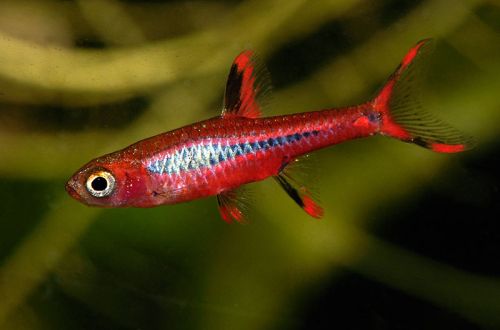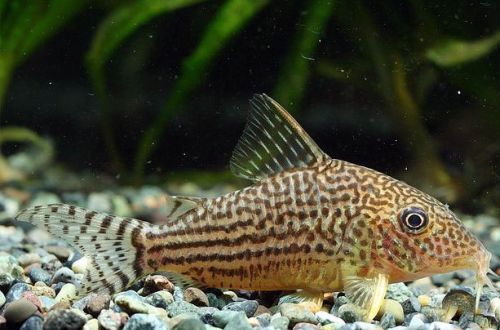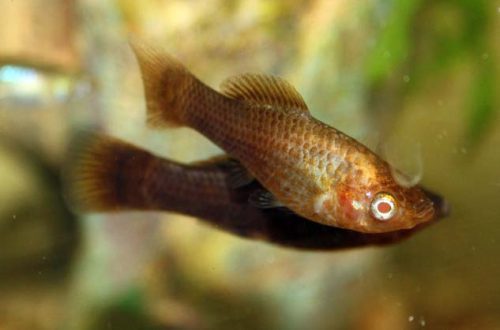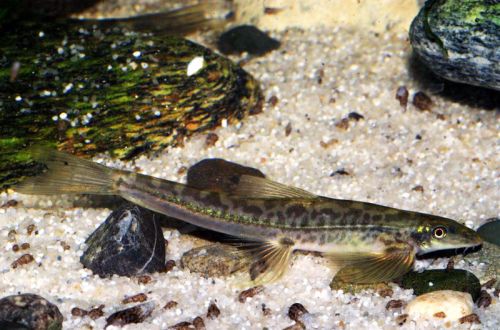
Brigitte Rasbora
Brigitte’s rasbora, scientific name Boraras brigittae, belongs to the Cyprinidae family. The fish was named after the wife of the researcher who discovered and described this species. Easy to maintain and unpretentious, it can become a wonderful decoration for any freshwater aquarium. May be recommended for beginner aquarists.

Contents
Habitat
Endemic to the western part of the island of Borneo in Southeast Asia. Inhabits peat bogs and related rivers and streams, located on the canopy of the tropical forest. Water in its natural habitat is colored in rich brown due to the abundance of tannins formed during the decomposition of plants, fallen leaves, branches, fruits and other things.
Brief information:
- The volume of the aquarium – from 40 liters.
- Temperature – 20-28°C
- Value pH — 4.0–7.0
- Water hardness – soft (1-10 dGH)
- Substrate type – any
- Lighting – subdued
- Brackish water – no
- Water movement is weak
- The size of the fish is 1,5–2 cm.
- Food – any food
- Temperament – peaceful
- Keeping in a group of 8-10 individuals
Description
Adults reach a length of only about 2 cm. The color is red with a black stripe running down the middle of the body. The fins are translucent with reddish or pink pigmentation. Sexual dimorphism is weakly expressed and consists mainly in the size of males and females, the latter are somewhat larger and have a rounded abdomen.
Food
Like most other Rasbors, this species is undemanding in terms of diet and will accept most popular foods of a suitable size. The daily diet may consist of dry flakes, granules, combined with live or frozen artemia, daphnia.
Maintenance and care, arrangement of the aquarium
The optimal size of the aquarium for a small flock of fish starts at 40 liters, although smaller volumes will be sufficient. The design uses a large number of aquatic shade-loving plants, including floating ones for additional shading, as well as a sandy substrate and various shelters in the form of snags. The lighting is subdued.
To give the water a characteristic brownish tint, dried tree leaves are placed at the bottom, which, in the process of decomposition, will saturate it with tannins. Read more about this in the article “Which tree leaves can be used in an aquarium.”
Keeping a Brigitte Rasbora tank is fairly easy if you follow a few essential steps: regular organic waste removal, weekly fresh water changes, and constant monitoring of pH and dGH.
When choosing a filter, it is advisable to give preference to models that do not cause excessive water flow, since these fish come from stagnant water bodies and are poorly adapted to life in conditions of strong water movement.
Behavior and Compatibility
Peaceful calm fish, compatible with other non-aggressive species of comparable size. The content in the group is at least 8-10 individuals, with a smaller number they will become shy and will constantly hide.
Breeding / breeding
In favorable conditions and in the presence of sexually mature females and males, spawning occurs regularly. The fish disperse their eggs in the water column and no longer show any parental care, and on occasion they can even eat their own offspring, so it is not surprising that the survival rate of fry in the general aquarium is extremely low.
If you plan to start breeding Rasbor Brigitte, then you will need to prepare in advance a separate tank with identical water conditions, where the eggs or the fry that have already appeared will be transferred. This spawning aquarium usually has a volume of 10-15 liters, is equipped with a heater and a simple airlift filter with a sponge. A separate lighting system is not required. Mosses or ferns are perfect as decoration.
The incubation period lasts 1-2 days, after another 24 hours the fry will begin to swim freely in search of food. At the first stage, it is necessary to provide microscopic food, for example, shoe ciliates. As they mature, around the second week, Artemia nauplii can be fed. It is feeding that is the most difficult when breeding.
Fish diseases
Hardy and unpretentious fish. If kept in suitable conditions, then health problems do not arise. Diseases occur in case of injury, contact with already sick fish or significant deterioration of the habitat (dirty aquarium, poor food, etc.). Read more about symptoms and treatments in the Aquarium Fish Diseases section.





